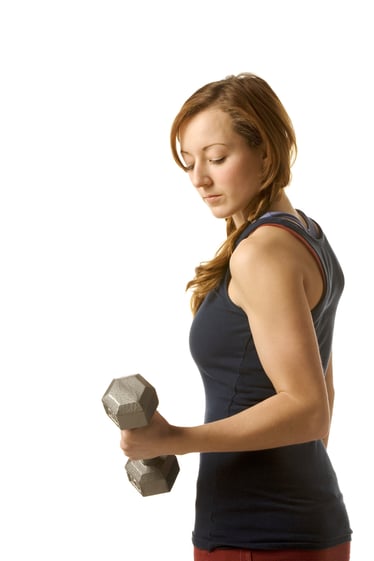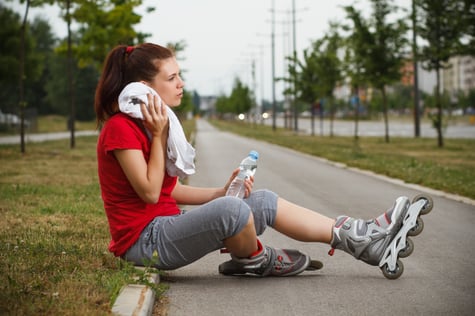 Six months ago, a friend dared me to give up cardio for three months and focus on strength training. My initial response was, “No way! I’m a runner, I’ve always been a runner. There is no better exercise than running!” My friend was relentless and eventually I agreed to take a brief hiatus, although I was convinced that I would turn into a mushy ball of goo if I didn’t get in my daily run.
Six months ago, a friend dared me to give up cardio for three months and focus on strength training. My initial response was, “No way! I’m a runner, I’ve always been a runner. There is no better exercise than running!” My friend was relentless and eventually I agreed to take a brief hiatus, although I was convinced that I would turn into a mushy ball of goo if I didn’t get in my daily run.
How I Changed My Workouts
Fast-forward six months. During this time, I’ve followed a low-impact exercise routine, which includes four days of low-impact strength activities such as yoga, one day of cardio, and one day of heavy weightlifting. And I have to say, the results are completely the opposite of what I expected.
How the Change Affected How I Look and Feel
What happened when I stopped doing cardio:
- I gained 10 pounds, but my body measurements decreased. This was perhaps the most surprising change that I noticed. Muscle tissue takes up much less space than fat. After nearly six months of strength training, I’ve added 10 pounds to my frame and my clothes are fitting better than ever—not to mention it feels good to look in the mirror.
- My energy levels skyrocketed. There is a reason why running burns so many calories: It’s HARD work! And when your body works that hard, you’re going to feel fatigued. Even if you sleep seven to eight hours a night, the physical strain of high mileage takes a toll on the body. I must admit that my energy levels are higher than they’ve ever been, even though I have a 5am alarm to fit in my exercise before work. In fact, I feel more fatigued on the days I don’t exercise!
- I’m not as hungry. This was a “well DUH” moment for me. Many people tend to focus on the calorie-burning power of running without stopping to think that your body will want to replace all those calories. Several weeks after I stopped running, I noticed that I had a much easier time regulating my food intake. I didn’t need to eat as much, but I felt fuller with the foods I did eat.
- I’ve noticed improvements in other areas of physical fitness. Previously, I was focused on distance, time, and miles. To me, a run wasn’t “a run” unless I ran at least four miles. Now I’m focused on how many pushups I can do with proper form (I’m getting close to 30!), how long I can hold a plank (nearly five minutes!), and how many pullups I can do (well, let’s just say I’m still working on this one).
- I have fewer injuries. Focusing on low-impact exercise and strength training has helped my body recover from more than two decades of intense, running-focused exercise programs. My legs no longer ache if I stand for more than an hour. My tight hip flexors are starting to relax, particularly as I focus on improving the flexibility and strength of my hamstrings and glutes.
In sum, to everyone out there who is worried about limiting their cardio because they don’t want to risk gaining weight, try it for three to four months. You might just be surprised at how different you feel and the gains you make!
Looking to help your employees move more?
Check out our free download below for more information on how to add exercise to your worksite!
*Weight loss claims or individiual results vary and are not guaranteed.


 According to a study published in the
According to a study published in the 
 Generally speaking, there are 3 “sections” to each fitness center. On one side, you have the cardio area. On the other side is the resistance area. And somewhere in the corporate fitness center is usually a group exercise room. The latter can be used for just about anything so we’ll leave that alone for the time being. That leaves us with the cardio and resistance areas.
Generally speaking, there are 3 “sections” to each fitness center. On one side, you have the cardio area. On the other side is the resistance area. And somewhere in the corporate fitness center is usually a group exercise room. The latter can be used for just about anything so we’ll leave that alone for the time being. That leaves us with the cardio and resistance areas.


 You don’t have to be a collegiate athlete to join in the fun of NCAA’s March Madness! The tournament is now in full swing. You may be glued to the TV and swept up in “bracketology,” but you can use the half-time breaks to sneak in a quick workout!
You don’t have to be a collegiate athlete to join in the fun of NCAA’s March Madness! The tournament is now in full swing. You may be glued to the TV and swept up in “bracketology,” but you can use the half-time breaks to sneak in a quick workout! Are you ready to make a change in your life? Have you been busy with a career or raising a family and put working out on the back burner? Most people’s activity level tends to significantly decrease in their 30s and 40s, and it only continues from there. It’s time to focus on you and spend just a few minutes each day doing something for yourself.
Are you ready to make a change in your life? Have you been busy with a career or raising a family and put working out on the back burner? Most people’s activity level tends to significantly decrease in their 30s and 40s, and it only continues from there. It’s time to focus on you and spend just a few minutes each day doing something for yourself. If you are new to group fitness, or new to the
If you are new to group fitness, or new to the  This past Tuesday, January 8,
This past Tuesday, January 8,  Bodycombat is for everyone at a moderate-intermediate fitness level, and the moves are simple so little coordination is required! When you attend a regular Bodycombat class, you should expect to be led by your instructor through the martial arts moves drawn from various disciplines such as karate, taekwondo, tai chi, and muy thai while moving to the beat of heart pounding music. At the end of the class, you will feel strong, empowered, and slightly invincible.
Bodycombat is for everyone at a moderate-intermediate fitness level, and the moves are simple so little coordination is required! When you attend a regular Bodycombat class, you should expect to be led by your instructor through the martial arts moves drawn from various disciplines such as karate, taekwondo, tai chi, and muy thai while moving to the beat of heart pounding music. At the end of the class, you will feel strong, empowered, and slightly invincible.  People everywhere are always searching for the best, most modern training device that will produce great results in the least amount of time. It is likely that you’ve tried the latest craze, yet you’re still searching for something more. Ironically, you may already own one of the most inexpensive yet effective training devices: the jump rope.
People everywhere are always searching for the best, most modern training device that will produce great results in the least amount of time. It is likely that you’ve tried the latest craze, yet you’re still searching for something more. Ironically, you may already own one of the most inexpensive yet effective training devices: the jump rope. There is never a better time to start than now. Pick up a jump rope and try this FREE workout.
There is never a better time to start than now. Pick up a jump rope and try this FREE workout.